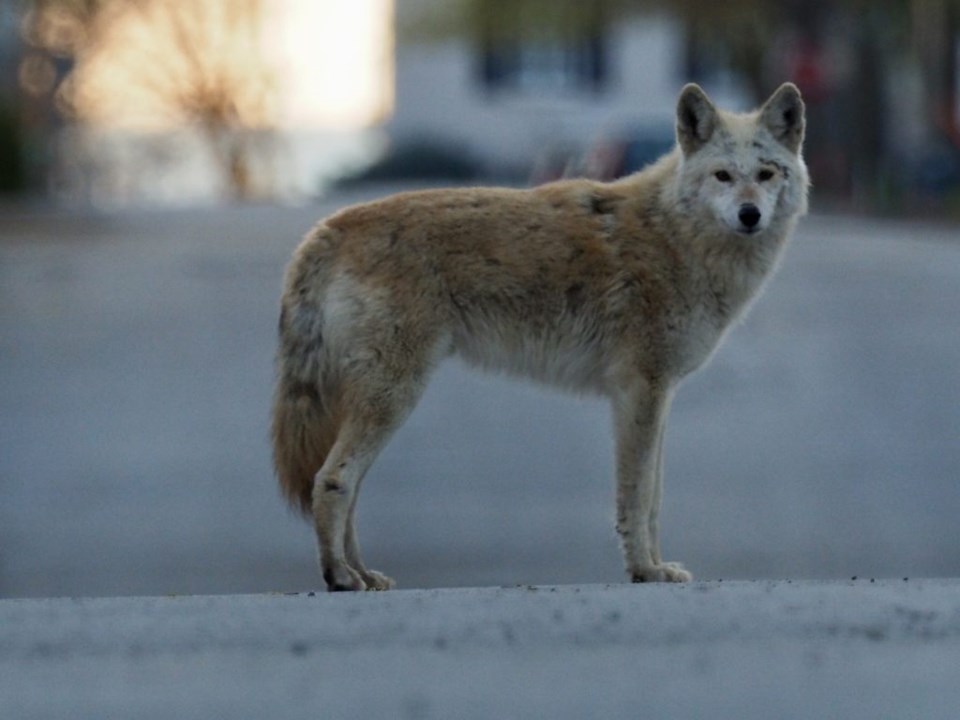
It worked in Niagara-on-the-Lake’s Garrison Village in 2019, and it has been effective in several other municipalities, those who tuned in to the town’s virtual coyote information session heard — if we simply stop providing meal sources, they’ll stop roaming our streets and terrorizing our residents and their pets.
Food left outside for feral cats, garbage bags coyotes can tear open, bird seed from feeders, brush piles that rabbits call home, and even food put out for the coyotes themselves are causing them to rove around the Old Town, often in daylight, frightening people who no longer feel safe walking through their neighbourhood, especially if they have small dogs.
For those who have a coyote approach them, Lesley Sampson of Coyote Watch Canada repeated the simple tricks she shared in 2019 to scare them off. Carry a garbage bag full of air and pop it, take an umbrella and snap it open, shout, wave your arms, and act aggressively and assertively, while picking up your dog. Look the coyote in the eye, and back away — whatever you do, don’t turn and run. Throw things, but not at the coyote. Whistles and horns might work, but don’t always, she said — and keep dogs on a short leash.
Providing insight as to who these animals are, Sampson explained that creating a safe and harmonious community for all, through best practices for co-existence, starts with the community.
“Everyone needs to be engaged, working together to establish safe, healthy and respectful boundaries for people and their beloved pets, and wildlife as well.”
There’s an “ebb and flow” to the presence of coyotes, she said. “It goes good for a while, and then it happens again.” In 2019, when the community rallied together, removed bird feeders and stopped feeding cats outdoors, “the coyotes moved out of the area. It can happen and does happen, but everyone needs to work together.”
Coyotes are great at foraging and hunting, and don’t need human handouts, which are harmful for them, Sampson said. Leave them to find their own food, and they can eat as many as 2,000 rodents a year.
Although there have been many coyote sightings and experiences shared on social media, while it might be well-meaning, Sampson said, it’s not always accurate, and it’s not a good place to turn to for information.
Sampson has seen the video of the woman and dog, and the coyote approaching them in the John and Gate Street area, and said the woman did everything right, acting aggressively with her dog’s leash, and it worked — the coyote fled, “especially with the man chasing it.”
In response to questions about when a coyote is acting too aggressively, when more action needs to be taken, Sampson said it’s difficult to know whether it’s one or two “bad actors,” and which ones are the aggressive animals.
Relocation isn’t an option, with coyote families established in a home range territory, she said.
“If you remove coyotes from the landscape, other coyotes will move in.”
There are more reliable sources for information than social media, including the town’s own website — it has done a good job of using its website to communicate with residents, she said.
The information session was organized in response to the growing number of human-coyote encounters and conflicts, with the intention of providing guidelines for best practices, said town CAO Marnie Cluckie, and was held in collaboration with several partners, including Coyote Watch, the Lincoln County Humane Society, the Niagara Regional Police, and representatives from the Ministry of Northern Development, Mines, Natural Resources and Forestry.
The provincial ministry does not provide animal control, the audience of about 240 people heard, but gives advice and information on how to prevent conflicts, how to find a licensed trapper, and actions municipalities can take to address conflict situations.
David Denyes, a provincial wildlife representative, explained under current provincial rules, in certain circumstances, such as preventing damage to your property, you can capture, harass or kill a coyote — however, if you capture it, you can only move it within a kilometre.
Cluckie acknowledged that coyote issue is a difficult situation, and that the town recognizes there have been some frightening situations.
“There is understandably fear, frustration and angst in the community,” and a variety of perspectives on how to handle the situation, some thinking it’s being taken to the extreme, others thinking the town should take more extreme measures, she said.
Other communities have followed the approaches discussed at the meeting, and successfully managed the canid-human conflict situation, she said, “so bear with us.”
Residents were asked to continue filling out sighting forms online, including the time of sighting.
An in-person coyote encounter demonstration will be on Wednesday, May 11, from 6 to 7 p.m. at the field behind the community centre.
Registration will be required and limited.